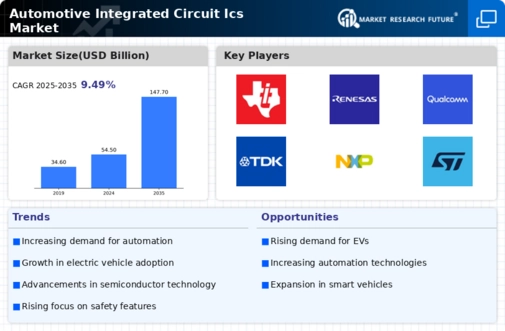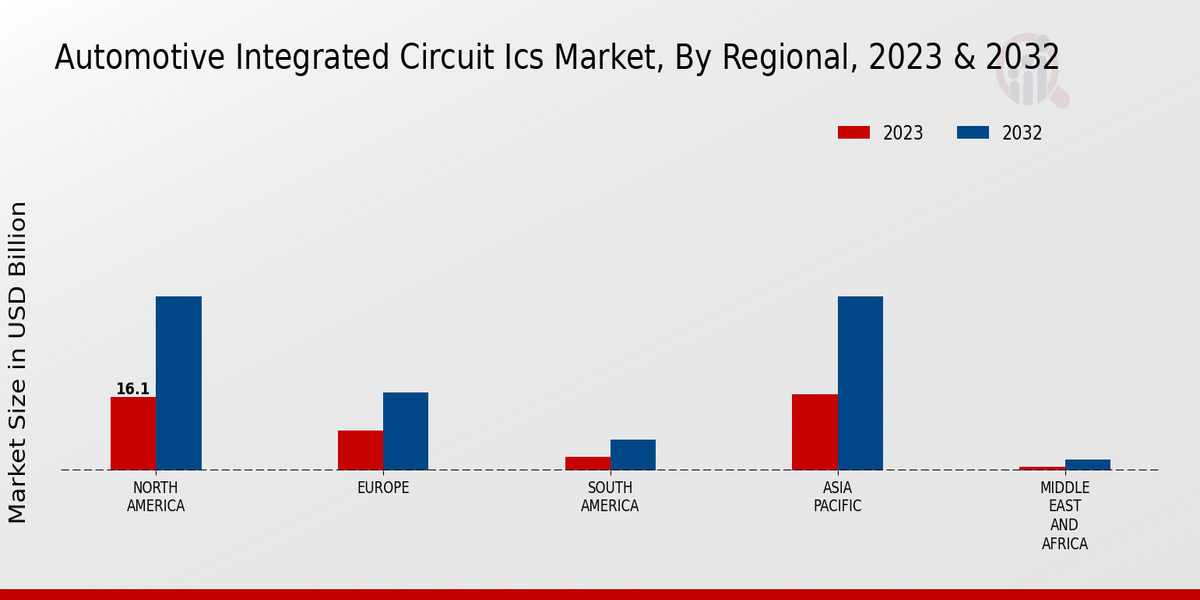Market Growth Projections
The Global Automotive Integrated Circuit Ics Market Industry is poised for substantial growth, with projections indicating a market size of 54.5 USD Billion in 2024 and an anticipated increase to 147.7 USD Billion by 2035. This growth trajectory suggests a compound annual growth rate (CAGR) of 9.49% from 2025 to 2035, reflecting the increasing integration of advanced technologies in vehicles. The market dynamics are influenced by various factors, including the rise of electric vehicles, advancements in autonomous driving, and the integration of IoT solutions, all contributing to a robust and evolving landscape.
Rising Demand for Electric Vehicles
The increasing adoption of electric vehicles (EVs) is a primary driver for the Global Automotive Integrated Circuit Ics Market Industry. As manufacturers pivot towards sustainable mobility solutions, the demand for advanced integrated circuits that manage battery systems, power distribution, and electric drivetrains escalates. In 2024, the market is projected to reach 54.5 USD Billion, reflecting the growing emphasis on EV technology. Furthermore, by 2035, the market could expand to 147.7 USD Billion, indicating a robust growth trajectory fueled by the need for efficient energy management and innovative automotive technologies.
Government Regulations and Safety Standards
Government regulations and safety standards play a crucial role in shaping the Global Automotive Integrated Circuit Ics Market Industry. Stricter emissions regulations and safety requirements compel manufacturers to adopt advanced technologies, including integrated circuits that enhance vehicle safety and reduce environmental impact. Compliance with these regulations often necessitates the incorporation of sophisticated electronic systems, which in turn drives demand for automotive ICs. As governments worldwide continue to prioritize safety and sustainability, the market is expected to experience sustained growth, reflecting the industry's adaptation to regulatory pressures.
Integration of IoT in Automotive Applications
The integration of Internet of Things (IoT) technology into automotive applications is reshaping the Global Automotive Integrated Circuit Ics Market Industry. IoT-enabled vehicles facilitate connectivity, allowing for real-time data exchange between vehicles and infrastructure. This connectivity enhances vehicle performance, maintenance, and user experience. As automakers increasingly adopt IoT solutions, the demand for integrated circuits that support these functionalities is likely to surge. The anticipated growth in this segment aligns with the broader trend of digital transformation in the automotive sector, further driving the market's expansion.
Advancements in Autonomous Driving Technologies
The evolution of autonomous driving technologies significantly influences the Global Automotive Integrated Circuit Ics Market Industry. As vehicles become increasingly equipped with sensors, cameras, and advanced driver-assistance systems (ADAS), the demand for sophisticated integrated circuits rises. These circuits are essential for processing vast amounts of data in real-time, ensuring safety and efficiency. The projected compound annual growth rate (CAGR) of 9.49% from 2025 to 2035 underscores the potential for growth in this sector, as manufacturers invest heavily in research and development to enhance vehicle autonomy and safety features.
Growing Consumer Demand for Enhanced Vehicle Features
Consumer preferences for enhanced vehicle features are a significant driver of the Global Automotive Integrated Circuit Ics Market Industry. Modern consumers increasingly seek vehicles equipped with advanced infotainment systems, connectivity options, and safety features. This demand compels manufacturers to integrate more sophisticated electronic systems, including integrated circuits, to meet consumer expectations. As a result, the automotive IC market is poised for growth, with manufacturers investing in innovative technologies to enhance the overall driving experience. This trend is likely to continue, further propelling the market's expansion in the coming years.
























